201938 Weak safety culture deals a crushing blow
As edited from official MAIB (UK) report 21/2018
A general cargo vessel was berthed and stevedores were discharging the vessel’s cargo of packaged timber from the holds. Once the
discharging of cargo had been completed a dockside crane was used to lift the ship’s cargo slings back on board. Deck crew, including the cookdeckhand who had come forward to announce that lunch was ready, decided to stow the slings in the fo’c’s’le stowage space before eating.
Two officers, an AB and the cook-deckhand began the work. The cook-deckhand walked around the starboard side of the open stowage space hatch cover and the AB then walked around the port side. Each then removed the locking pin from the hatch cover hinge closest to them.
Then, as the crane hook was being lowered, the cook-deckhand climbed up the inside of the hatch cover, using the framing as hand and foot holds, and reached up to grab the lifting slings. As he did so the hatch cover fell forward, trapping him between the hatch cover and the hatch coaming.
The other attending crew tried desperately to manually lift the hatch cover to release the victim, but it was too heavy. The alarm was raised and the dockside crane driver immediately swung his crane jib back over the fo’c’s’le. The hatch cover was quickly raised by the dockside crane and the victim was lifted, unconscious, on to the deck where he received first aid.
Paramedics soon arrived on board, but were unable to revive the victim and he was declared dead at the scene. After the accident, the deck crew were subject to onboard alcohol breath testing by the vessel’s Master, in accordance with the company’s drug and alcohol policy. The results for each crew member were negative. However, a post-mortem toxicology test identified that the victim had a blood alcohol level of 75mg/100ml.
Some of the report’s analysis and findings are as follows:
- It was not appropriate to require crew to climb on to hatch coamings and squeeze into tight spaces, or to walk across uneven surfaces and climb up the inside of the hatch cover when opening and closing the fo’c’s’le stowage space. Had this operation been thoroughly reviewed, alternative solutions could have been identified and put in place.
- The stowage space hatch cover fell on top of the victim because he climbed on it after its locking pins had been removed. This action was the result of inadequate procedures.
- The vessel’s SMS was immature. Risk assessments had not been conducted for some routine deck operations, a safe system of work.

